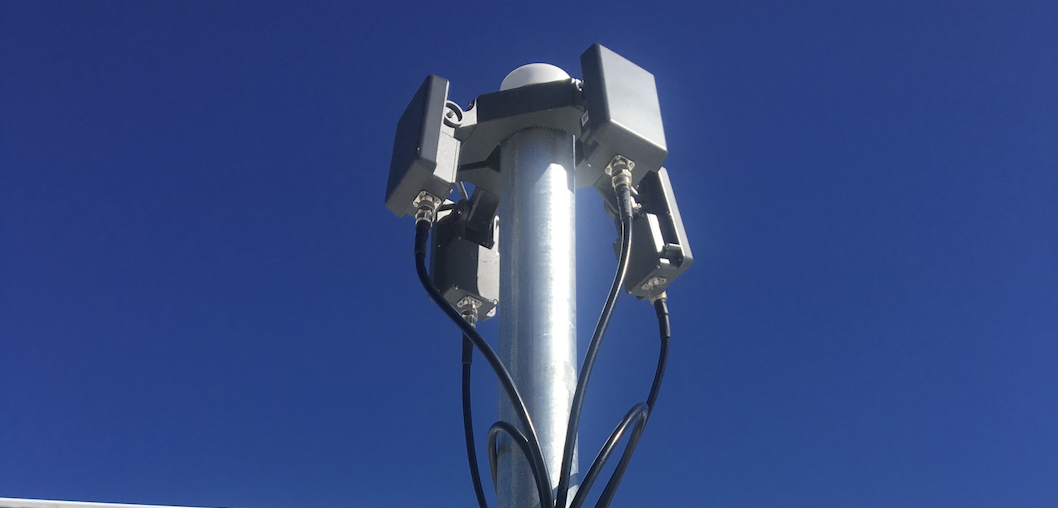How does a radar work?
Radar systems provide proactive airspace security by emitting short pulses of signal, operating in the K-band frequency range. When these signals encounter an object, the echoes are captured by the radar antenna and amplified to identify the object's nature. Radars continuously scan the sky looking for reflections and changes to detect movement and size, providing 24/7 monitoring in a wide range of weather conditions.
While traditional radar is great for locating large aircraft, commercial drones have a much smaller Radar Cross Section (RCS). For this reason, high-resolution radars, like those used by AirGuard, are specifically designed for effective drone detection.
What is a Radar Cross Section (RCS)?
Radar Cross Section (RCS) is a measure of how detectable an object is by radar. The more a radar's signal is reflected back, the more accurately it can be detected. This is determined by several factors, including the object's size and the materials it's made from. In the case of commercial drones, the RCS is low as the only significantly reflective components are typically the batteries and motors.
Can a radar detect a drone?
Yes, the high-resolution radars integrated into the AirGuard platform are specifically designed for drone detection and tracking. Reflected signals are analyzed and compared to a database for drone characterization. The stored signatures can also be used to eliminate non-drone objects, like birds. This signal processing greatly improves detection performance and allows for fewer false positives.
Radar can also provide real-time tracking by providing the GPS location of the drone detected. The GPS location is calculated based on the GPS location of radar sensor, and distance and angle at which object is detected from the radar sensor.
How far can a radar detect a drone?
The detection range depends on the drone's size (RCS). The AirGuard radar system has a specific detection range based on these differences:
- For small drones (less than 12 inches in length), the detection range is up to 1,969 feet (approximately 0.4 miles).
- For larger drones (greater than 12 inches in length), the range extends up to 4,921 feet (approximately 0.9 miles).
The range is affected by Drone size. Radar detection range is also slightly affected by weather conditions like rain and fog.
Can a radar detect all types of drones?
Yes, radar can detect all types of drones regardless of whether they use RF, GPS pre-programming, or cellular communication. The primary limit to radar detection is size; the AirGuard radar can detect all drones larger than 6 inches. Drones smaller than this typically do not pose a significant threat as they cannot carry a meaningful payload.
Does a radar give false positive while detecting drones?
A radar can give a false positive, as it initially detects all flying objects that meet certain size and speed criteria. To combat this, AirGuard uses advanced signal processing and AI Aircraft Type Classification to differentiate drones from other objects, which greatly improves detection performance and reduces false positives. For maximum reliability, we add a final layer of 24/7 Live Human Confirmation. Our team provides manual confirmation using visual identification to ensure that any potential false alerts are filtered out, leaving you with only real, verified threats. This layered approach of technology and human oversight is the best way to confirm whether an alert is a real threat.
Will one radar sensor give full visibility and detect all drones in an area?
It depends on the specific sensor. Some radar sensors have a limited field of view (e.g., 90 or 120 degrees). While some systems can be set up to rotate for 360-degree coverage, our Airspace Security experts typically recommend using RF sensors for broad coverage and then layering radar systems over the most critical areas.
How many radars do I need to cover my area?
Radars are expensive compared to other sensors and have limitations like field of view. Achieving complete 360-degree detection using only radar is often not cost-effective. For this reason, radars are best used as an additional layer over a critical area, along with Remote ID, RF, and visual detection for a complete and cost-effective solution.
AirSight helps you conduct thorough reviews of your environment and can propose the best configuration of where to use a radar to achieve the best security posture to match your budget. Schedule a call with one of our Airspace Security experts to get started.
How can I view, track and get alerted to a drone detected by a radar?
A radar sensor can be accompanied by its own software, but using different software for different sensors can be confusing and increases the time it takes to identify and respond to threats.
AirSight’s Drone Detection Software Solution, AirGuard, integrates data from radar and all other detection systems into one user interface, so you can quickly assess and respond to any aerial threats.
Radar & Camera Technical Specifications
For those interested in the technical details, our Complete Tier solution includes the following:
Radar:
- Dimensions: 8.00 in x 6.42 in x 1.57 in
- Weight: 2.76 lb
- Power: +15 to +28 VDC, 50W Operating Power, < 10W Hot Standby
- Operating Temperature: -40°F to +167°F
- Ingress Protection Rating: IP67
- Mounting: VESA 75 & 100 mm
Camera:
- Casing: IP66-, IP68-, NEMA 4X- and IK10-rated aluminum casing
- Features: Includes a silicone wiper blade and is PVC free.
- Power: High Power over Ethernet, max 90 W
- Resolution: HDTV 1080p (1920x1080) down to 320x180
- Day/Night Functionality: Automatically removable infrared-cut filter for clear imaging in all lighting conditions.










